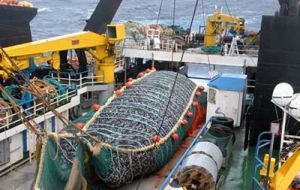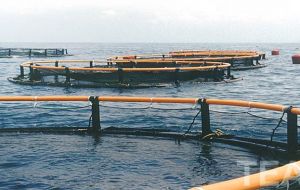MercoPress. South Atlantic News Agency
FAO warns fisheries and aquaculture threatened by harmful practices and poor management
 Almost 60% of fisheries are very close to their maximum sustainable production
Almost 60% of fisheries are very close to their maximum sustainable production  Global aquaculture production marked a record high of more than 90 million tons in 2012
Global aquaculture production marked a record high of more than 90 million tons in 2012  Global marine capture fishery production was stable at about 80 million tons in 2012
Global marine capture fishery production was stable at about 80 million tons in 2012 More people than ever before rely on fisheries and aquaculture for food and as a source of income, but harmful practices and poor management threaten the sector’s sustainability, says a new report published by FAO.
According to the latest edition of FAO’s The State of the World Fisheries and Aquaculture, global fisheries and aquaculture production totaled 158 million tons in 2012 - around 10 million tons more than 2010. The rapid expansion of aquaculture, including the activities of small-scale farmers, is driving this growth in production.
Fish farming holds tremendous promise in responding to surging demand for food which is taking place due to global population growth, the report says.
At the same time, the planet's oceans – if sustainably managed – have an important role to play in providing jobs and feeding the world, according to FAO's report.
“The health of our planet as well as our own health and future food security all hinge on how we treat the blue world,” FAO Director-General José Graziano da Silva said. “We need to ensure that environmental well-being is compatible with human well-being in order to make long-term sustainable prosperity a reality for all. For this reason, FAO is committed to promoting 'Blue Growth,' which is based on the sustainable and responsible management of our aquatic resources.”
The renewed focus on the so-called “blue world” comes as the share of fisheries production used by humans for food has increased from about 70% in the 1980s to a record high of more than 85% (136 million tons) in 2012. At the same time per capita fish consumption has soared from 10 kg in the 1960s to more than 19 kg in 2012.
The new report also says fish now accounts for almost 17% of the global population’s intake of protein -- in some coastal and island countries it can top 70%.
FAO estimates that fisheries and aquaculture support the livelihoods of 10–12% of the world’s population.
Since 1990 employment in the sector has grown at a faster rate than the world’s population and in 2012 provided jobs for some 60 million people engaged in capture fisheries and aquaculture. Of these, 84% were employed in Asia, followed by Africa with about 10%.
However global marine capture fishery production was stable at about 80 million tons in 2012, the new report indicates.
Currently, under 30% of the wild fish stocks regularly monitored by FAO are overfished – a reversal in trend observed during the past few years, a positive sign in the right direction.
Just over 70% are being fished within biologically sustainable levels. Of these, fully fished stocks – meaning those at or very close to their maximum sustainable production – account for over 60% and under-fished stocks about 10%.
Global aquaculture production marked a record high of more than 90 million tons in 2012, including almost 24 million tons of aquatic plants. China accounted for over 60% of the total share.
Aquaculture’s expansion helps improve the diets of many people, especially in poor rural areas where the presence of essential nutrients in food is often scarce. However, the report warns that to continue to grow sustainably, aquaculture needs to become less dependent on wild fish for feeds and introduce greater diversity in farmed culture species and practices.
For example, small-sized species can be an excellent source of essential minerals when consumed whole. However, consumer preferences and other factors have seen a switch towards larger farmed species whose bones and heads are often discarded.
The role of fish is set to feature prominently at the Second International Conference on Nutrition jointly organized by FAO and the World Health Organization (WHO) for 19–21 November 2014 in Rome.




Top Comments
Disclaimer & comment rules-

-

-

Read all commentsPerhaps we are all eating to much,
May 21st, 2014 - 12:20 pm 0yet somehow one imagines that once,, 5 fishes and the odd loaf was more than enough,lolol.
I know I am. No more fishcakes for me!
May 22nd, 2014 - 12:29 am 0ha ha .
May 22nd, 2014 - 09:51 am 0Commenting for this story is now closed.
If you have a Facebook account, become a fan and comment on our Facebook Page!